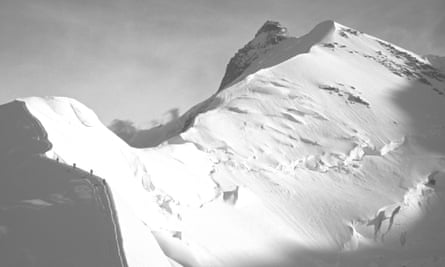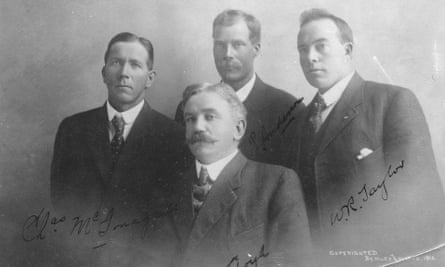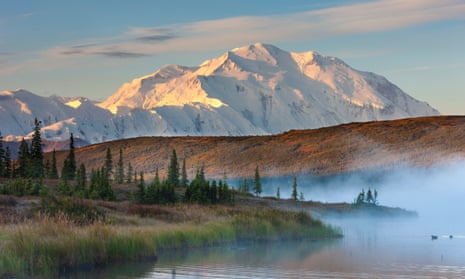April 1910. High above their diggings in the mining district of Kantishna, three Alaskan prospectors stopped to catch their breath in the thin, subzero air of America’s highest peak. They had launched the most outrageous and difficult ascent in the early annals of mountaineering.
They knew that their leader, Tom Lloyd, had boasted up a storm back in Fairbanks that got them here. But while worried about how his storytelling might cloud their achievement, there was no stopping now. They’d spent the whole winter preparing. They were going up.
Lloyd, Peter Anderson, William Robert Taylor, and Charles McGonagall were already renowned among the tight fraternity of northerners for pioneering winter trails and deep-shafted mines. According to Lloyd’s in-depth story released two months later in the New York Times, they had spent the gray, dawn hours of April 3, 1910, weaving up a difficult ridge. This white, wind-blasted spine – later named Karstens Ridge – yawned from 11,000 to 14,600 feet and had already cost them several days of preparatory shoveling.
In the early twentieth century, most alpinists slogged up low-angled peaks tied to their guides with hemp ropes, lugging scientific equipment, clad in tweedy sport coats, and clutching ice axes with four-point, “creeper” claws strapped to their leather boots for traction. No one carried shovels. The old-school purists hammered in small spikes, called hobnails, through their boot soles. But on Denali, the four neophytes were unknowingly redefining alpinism. They disdained ropes, didn’t understand their barometer (which they lost), wore striped cotton parkas made out of mattress ticking, wielded awkward eight-foot-long pike poles instead of axes and were shod with innovative nine-point galvanized sheet-metal crampon-creepers under knee-high moccasins made of moose hide. As if the steep terrain wasn’t challenge enough, they hefted a fourteen-foot, twenty-five-pound flagpole – cut out of the forest below – over their shoulders. Along with their medieval pike poles, they charged up the mountain like errant knights ready to lance their enemy.
They had come to Alaska to seek their fortunes and make their own rules, to escape the factory lands, to live free in the fresh air. Government be damned. So it followed, logically, that even here on the isolated mountain, they were ignoring the conventions of turn-of-the-century alpinism by climbing so lightly clad with cumbersome pike poles, moving hastily across such unjustifiably dangerous and unknown terrain. No one had ever committed to a route of this scale or steepness.
They were climbing unroped, an amazing act of bravado given so much space beneath their feet. A single misplaced step on the steep, snow-blanketed east side of the ridge would’ve sent them into bouncing arcs more than a mile down to the Tralieka Glacier. The ridge itself stretched several times higher than the world’s tallest skyscraper, Madison Avenue’s Met Life Tower; the ridge proffered no rock, soil, or bare earth to step upon. Its only two flat, small resting spots were covered with an ever-shifting mantle of snow. The more forgiving north slope of the ridge, although not initially as steep, eventually dropped off into a sheer, unstable formation soon to be named the Harper Icefall. It resembled an enormous frozen waterfall, breaking the otherwise smooth-surfaced glacier into an ice cliff that periodically cascaded refrigerator-to-boxcar-sized ice blocks into the valley below. This hanging glacier – compressed from ancient snowflakes into cerulean-white, gem hardness – was one of many encircling and guarding the upper half of the mountain. (Over the next century, dozens of climbers would become irretrievably crushed and buried when these hanging glaciers exploded.)

Below this disconcerting real estate, the miners could just make out their “Tunnel Camp” at the head of the ice valley that they renamed “Wall Street.” Already named eight years earlier for a government surveyor (a name that the contrary prospectors ignored), the Muldrow Glacier is riddled with deep, hidden crevasses. This sluggish, thirty-four-mile-long, frozen river of ice groaned and cracked and bulldozed against its shoreline of towering peaks. It had done so, they knew, since long before humankind had seen the mountain. Their Wall Street curled out of sight into a jumbled black terminus of precariously perched argillite boulders and other worthless rock till feeding the McKinley River.
Not adverse to risks as knowledgeable miners and Alaskan pioneers, these men had never climbed a mountain before. But they were on a mission that had nothing to do with gold. As the story goes, they would top out on this heretofore unknown ridge, then verge off onto even steeper terrain to the summit and back, all in one day. More than eight thousand feet, round-trip, at high altitude and in winter conditions. Up and down a steep, hard ice gully and snow ridge without ropes or knowledge of climbing techniques.
Today’s experts who have repeatedly climbed the mountain and have examined the route describe the 1910 accomplishment as unbelievable partly because the climb has never been repeated. There are modern, professional alpinists capable of climbing the route without ropes. They would benefit, of course, from route descriptions, maps, and photographs showing each rugosity on the mountain. But these athletes would not attempt to match the first ascensionists’ speed in winter with such primitive gear and a heavy flagpole over their shoulders.
While these 1910 miners and their backgrounds are forgotten, contemporary historians call them simply (yet erroneously) “the Sourdoughs.” Much of their climb remains misunderstood and shrouded in mystery. But now – aided by new research and modern technology – the veracity of their ascent and how they actually performed it can be teased out, explained, and, ultimately, revealed.
To understand their story, it’s helpful to look to what little is known about their lives. Lest they be forgotten.
The porcine Welshman, Lloyd, had a gift, as a mining entrepreneur, for discovering underground minerals and countless aboveground opportunities. He would make and lose a fortune in gold. As the Carbon County sheriff in Utah, he repeatedly shot it out with wanted murderers. Once he even led a posse that tracked down the infamous outlaw Butch Cassidy to his hideout in the southern part of that state.

His employee, McGonagall, was a lifelong, irritable bachelor and jack of all trades whose name was spelled at least four different ways but still ended up on the map denoting his discovery of the crucial access pass (seldom used by modern climbers) to the mountain. Like all three of his partners, Denali was the only mountain in his life.
The handsome Swede, Anderson, would outlive his first two wives and later, as a septuagenarian, marry a woman twenty-three years younger. At forty-three, his employer, Lloyd, called him “indefatigable” on the mountain, and, apparently, everywhere else.
Taylor, Lloyd’s Canadian partner, was a slab of muscle, friendly and hardworking, while his 1937 interview – given on the fly as he emerged from a wilderness dogsled trip at a Denali roadhouse – filled in some of the blanks about their misunderstood climb.
Pulling together the obscure pieces, their climb would be widely praised. Bill Sherwonit, author of To the Top of Denali, asked a score of veteran Alaskan climbers in the 1980s to name the most significant ascents in the state and learned that the 1910 climb resonated more than any other achievement. One respondent, a former mountain guide, called the Sourdoughs “superhuman by today’s standards.”
Their supposed accomplishment also remains more than an unforgettable Alaskan ascent. “Eventually,” wrote the historian Dee Molenaar in the 2002 American Alpine Journal (the worldwide almanac of climbing), “it was deemed one of the greatest feats in mountaineering history.”
It was also widely accepted that no one had ever climbed so high before 1910, despite several attempts. Aside from the climbing challenge, the journey demanded route-finding, bushwhacking, boating, hunting, and dogsledding skills just to reach the mountain’s base. Crudely surveyed at twenty thousand feet a dozen years earlier, Denali itself remained unmapped terra incognita.
These particular four miners called the peak “Mac” after the assassinated President McKinley, but it would take another seven years for Congress to officially switch the age-old Denali name to Mt McKinley. As three penurious gold prospectors, and Lloyd a conservative party activist, the 1910 climbers cherished their departed Republican, William McKinley. Although he never visited Alaska, he signed the Gold Standard Act that backed American currency and further elevated the value of the precious yellow metal.
The miners had undertaken this audacious climb from the north, because the outsider Dr Cook, a Democrat, claimed to summit from the inaccessible south side during the snowy month of September 1906. This boast incensed most Alaskans, fanned into rage, in part, by the Fairbanks newspaper editor WF Thompson, who referred to Cook and other easterners clambering onto their mountain as “bespectacled highbrows.” Only sturdy men of the North, whipped into shape by laboring in the wilderness and living on the frozen trail, had what it took to climb To the Top of the Continent – the title of Cook’s 1908 book. Since the climb was widely believed to be a fairy tale, someone needed to summit if only to prove Cook hadn’t deposited a flag or anything else up there. And only an Alaskan could do it.

Comments (…)
Sign in or create your Guardian account to join the discussion